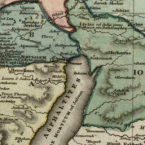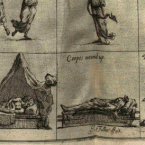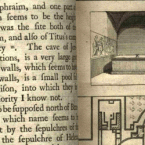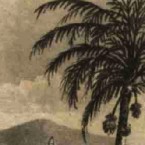Palestine in the World
International maps enjoin us to think of the “world” as a collection of states, constituted by boundaries that do not overlap, or vie for meaning—as a body made of discrete and distinct organs, plots of land, that each proceed according to one specific nationalist function. In the lived world, however, physical geography may often concede reality to the imagination, national policy may be less decisive than individual perspective, and no one place can be separated from the others, just as no organ grows independently from the body. This case is about books that perceive Palestine through international lenses, and see it as part of the world.
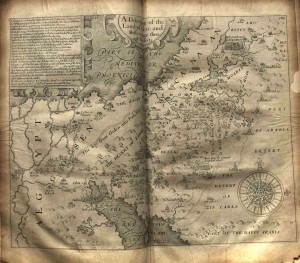
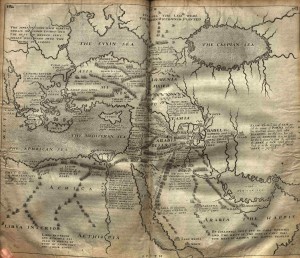 Any contemporary historian of the “world” would surely find it difficult not to devote a focused section to Palestine, but both visualizations of the region in Raleigh’s monumental tome portray Palestine as a part of other places rather than as its own definite region. While it’s the centre of a broad view of the Middle East, the area is trailing up towards the top of the page in the map of the way Moses took from Gosen to Palestine. The destination, here, is less worth visualizing than the journey. Raleigh’s captions for his maps give dynastic histories associated with the regions, illustrating a contest between history and geography for primacy in the communicative intent of the documents.
Any contemporary historian of the “world” would surely find it difficult not to devote a focused section to Palestine, but both visualizations of the region in Raleigh’s monumental tome portray Palestine as a part of other places rather than as its own definite region. While it’s the centre of a broad view of the Middle East, the area is trailing up towards the top of the page in the map of the way Moses took from Gosen to Palestine. The destination, here, is less worth visualizing than the journey. Raleigh’s captions for his maps give dynastic histories associated with the regions, illustrating a contest between history and geography for primacy in the communicative intent of the documents.
The travels undertaken in the pages 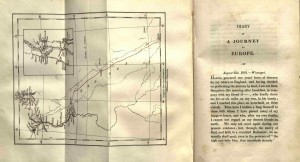 of this beautiful blue book, were, according to the author, prompted by “circumstances of a private nature and which must therefore be totally uninteresting to others” (2). The seductions of this tantalizing deferral of readerly curiosity highlight the beckoning mystery behind all reasons for travel. Why anyone goes anywhere is often as remarkable as a destination. Prior to commencing his travels Mackworth was “a field officer of cavalry,”
of this beautiful blue book, were, according to the author, prompted by “circumstances of a private nature and which must therefore be totally uninteresting to others” (2). The seductions of this tantalizing deferral of readerly curiosity highlight the beckoning mystery behind all reasons for travel. Why anyone goes anywhere is often as remarkable as a destination. Prior to commencing his travels Mackworth was “a field officer of cavalry,”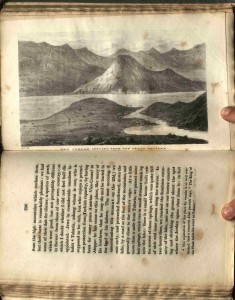 and had professional cause to spend some time in India. Palestine was thus a logical destination on the way. Had Britain not had interests in India, however, and had topography not made his visitation easy, Palestine might have remained a dark spot on the mental maps of Mackworth and his hypothetical readers. In the universe created by this book, therefore, the region comes into being because of its geographic and epistemological proximity to other parts of the world—making one place can become very difficult to detach from another. I’ve included this image, captioned, “The Jordan issuing from the Sea of Galilee,” because it recalls the conflicted representations of international geography and its vexed indebtedness to topography. While the Jordan today acts as border to a place whose deeply contested political definitions belie the very real course of the river itself, at other moments and with other perspectives the waterway could be seen not as a dividing line, but as a liquid vector flowing with an energy and meaning all its own.
and had professional cause to spend some time in India. Palestine was thus a logical destination on the way. Had Britain not had interests in India, however, and had topography not made his visitation easy, Palestine might have remained a dark spot on the mental maps of Mackworth and his hypothetical readers. In the universe created by this book, therefore, the region comes into being because of its geographic and epistemological proximity to other parts of the world—making one place can become very difficult to detach from another. I’ve included this image, captioned, “The Jordan issuing from the Sea of Galilee,” because it recalls the conflicted representations of international geography and its vexed indebtedness to topography. While the Jordan today acts as border to a place whose deeply contested political definitions belie the very real course of the river itself, at other moments and with other perspectives the waterway could be seen not as a dividing line, but as a liquid vector flowing with an energy and meaning all its own.
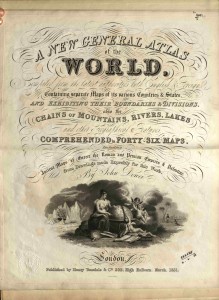 “A new General Atlas of the WORLD,” the frontispiece announces with breathless flourishes and swoops in the only sentence of this book,
“A new General Atlas of the WORLD,” the frontispiece announces with breathless flourishes and swoops in the only sentence of this book,
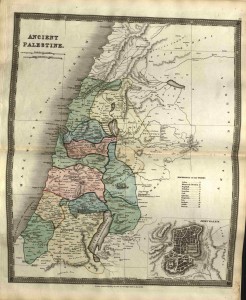 English and Foreign, Containing separate Maps of its various Countries & States,
English and Foreign, Containing separate Maps of its various Countries & States,and Exhibiting their Boundaries and Divisions,
also the
Chains of Mountains, Rivers, Lakes,
and other Geographical Features,
Comprehended in Forty-Six Maps,
Including
Ancient Maps of Greece, the Roman and Persian Empires, & Palestine,
from Drawings made Expressly for this Work,
By John Doner.
The dazzling kitsch of the engraved frontispiece combines no less than ten fonts 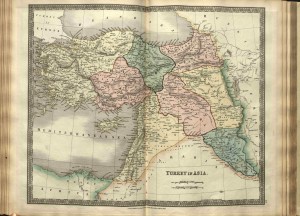 with as many incongruous geographic symbols, so that camels lope towards a polar bear on either side of cherubs and a Madonna enjoying a pedagogic moment over a globe. In its enthusiastic encounter with the “WORLD”—a rather nebulous idea at all moments—this proseless collection of maps offers a rather conflicted set of representations that seem torn between conceding to physical geography, empire, or history as the primary force organizing knowable reality. Although this book represents the region twice, in the transnational and locationally vexed map of the Ottoman empire, entitled, “Turkey in Asia,” and in the map of “Ancient Palestine,” Palestine as a contemporary place occupied by Palestinians does not exist in the “WORLD” it creates.
with as many incongruous geographic symbols, so that camels lope towards a polar bear on either side of cherubs and a Madonna enjoying a pedagogic moment over a globe. In its enthusiastic encounter with the “WORLD”—a rather nebulous idea at all moments—this proseless collection of maps offers a rather conflicted set of representations that seem torn between conceding to physical geography, empire, or history as the primary force organizing knowable reality. Although this book represents the region twice, in the transnational and locationally vexed map of the Ottoman empire, entitled, “Turkey in Asia,” and in the map of “Ancient Palestine,” Palestine as a contemporary place occupied by Palestinians does not exist in the “WORLD” it creates.
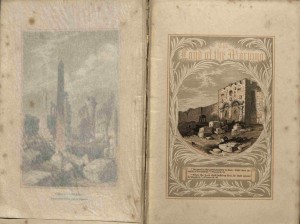 This rather unappealing little book
This rather unappealing little book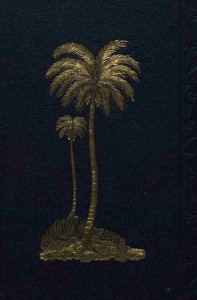 opens with a declaration that Palestine’s history as a Promised Land parallels Eng- land’s own state in the nineteenth century and
opens with a declaration that Palestine’s history as a Promised Land parallels Eng- land’s own state in the nineteenth century and
its rights to other places. This colonial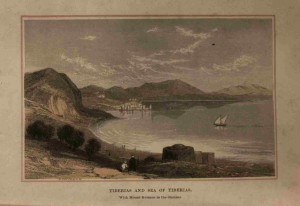 sentiment is as distasteful as the mechanical two-tone shading the publishers added to the engraved illustrations that follow. While a gold palm tree appears on the embossed cover of this book, the camel that would complete this typical iconography of “Palestine” is missing.
sentiment is as distasteful as the mechanical two-tone shading the publishers added to the engraved illustrations that follow. While a gold palm tree appears on the embossed cover of this book, the camel that would complete this typical iconography of “Palestine” is missing.
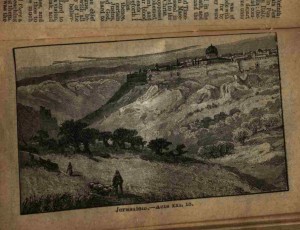 The cover of this, the tiniest, and perhaps the
The cover of this, the tiniest, and perhaps the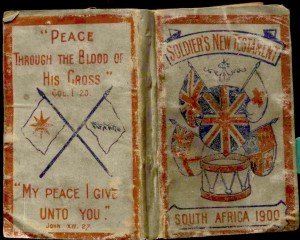 most astonishing of the books in this collection, is exceedingly well-worn and painted with nationalist signifiers: it is either a religious book- object masquerading as a talisman of national fervour, vice versa, or both. This religious and political layering of authorities,
most astonishing of the books in this collection, is exceedingly well-worn and painted with nationalist signifiers: it is either a religious book- object masquerading as a talisman of national fervour, vice versa, or both. This religious and political layering of authorities, 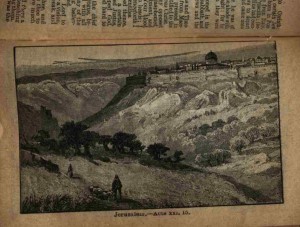 sentiments, inspirations, and appeals is well-advised, since the book was printed to be taken by soldiers to the Boer War, one of the last wars to be fought by Britain for purely and admittedly Imperial goals (Saunders and Smith, 618). The date and location
sentiments, inspirations, and appeals is well-advised, since the book was printed to be taken by soldiers to the Boer War, one of the last wars to be fought by Britain for purely and admittedly Imperial goals (Saunders and Smith, 618). The date and location 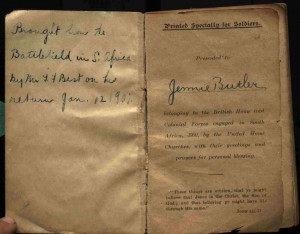 of the war at hand are even noted on the binding of the book as though in a kind of notch-marking of conquests. This object tells a very poignant fable of international relations brought down to the scale of the individual. Intended as spiritual incitement to soldiers, the cogs of Britain’s colonial system, this book invites the odd notion that images of Palestine were used to muster the conquest of South Africa. This hypothesis itself casts a strange light on the “view” of Palestine taken by Balfour seventeen years later and highlights the seepage of the idea of a “Promised Land” into colonial epistemology. Either the inheritance of the concept spurred the feelings of entitlement of early colonialists, or thinking of Palestine as “promised” and therefore already possessed seemed natural to those immersed in the imperial project—or both.
of the war at hand are even noted on the binding of the book as though in a kind of notch-marking of conquests. This object tells a very poignant fable of international relations brought down to the scale of the individual. Intended as spiritual incitement to soldiers, the cogs of Britain’s colonial system, this book invites the odd notion that images of Palestine were used to muster the conquest of South Africa. This hypothesis itself casts a strange light on the “view” of Palestine taken by Balfour seventeen years later and highlights the seepage of the idea of a “Promised Land” into colonial epistemology. Either the inheritance of the concept spurred the feelings of entitlement of early colonialists, or thinking of Palestine as “promised” and therefore already possessed seemed natural to those immersed in the imperial project—or both.
Next: Bibliography
